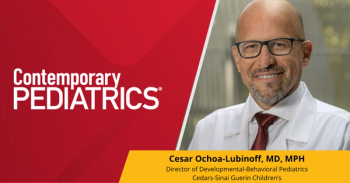
- Consultant for Pediatricians Vol 9 No 10
- Volume 9
- Issue 10
Children With Gigantism, Hypotonia, and an Unusual Facial Appearance
The children shown here have the same congenital condition. This disorder presents with increased birth weight, length, and head size, with subsequent rapid growth
The two children shown here have the same congenital condition. This disorder presents with increased birth weight, length, and head size, with subsequent rapid growth. Both of these children had early hypotonia with severe motor delays and subsequent clumsy gait, mildly delayed speech-language development, and distinctive craniofacial features-as shown in the Figure. They also had early tooth eruption (their bone age assessed by hand/hemiskeletal radiographs would be accelerated). Their height and weight measurements were at the 97th percentile for age; their head circumference measurement, significantly above the 97th percentile, which provoked concerns about hydrocephalus. Although head size remains large, height and weight often normalize with early pubertal development.
• WHAT IS THE DIAGNOSIS?
• WHAT MEDICAL COMPLICATIONS CAN BE EXPECTED?
ANSWERS:
•Sotos syndrome, or cerebral gigantism, is characterized by overgrowth, macrocephaly, craniofacial changes, large hands and feet, early hypotonia with motor delays, and mild to moderate cognitive disability (mean IQ of 78).1-3
• Medical complications include hypotonia, with early feeding problems and constipation; strabismus; chronic otitis media; congenital heart defects (patent ductus arteriosus, septal defects); urological anomalies; clumsiness, with an increased frequency of fractures; orthopedic problems, such as scoliosis or flatfoot; mild to moderate cognitive disability, with behavior differences (autism and attention- deficit/hyperactivity disorder; and an increased risk of certain cancers.1-6
INCIDENCE AND ETIOLOGY
Sotos syndrome is thought to occur in 1 in 14,000 persons.1,2 The condition exhibits autosomal dominant inheritance. Most cases are new mutations, as supported by elevated age of the fathers, and represent changes in the nuclear receptor-binding gene NSD1. Microdeletion or microduplication of NSD1 at chromosome band 5q35 can be detected by high-resolution chromosome analysis (fluorescent in situ hybridization or microarray analysis) in 50% of Japanese patients but in only 10% of Occidental patients with NSD1. A molecular diagnosis is usually unnecessary; however, it allows for preimplantation or prenatal diagnosis in affected parents, who have a 50% chance of passing on the condition.2 Information and support for parents are available online (Box).
CLINICAL DIAGNOSIS AND DIFFERENTIAL
The diagnosis of Sotos syndrome is first suspected in a child with a high birth weight/length, large head, and neonatal hypotonia. As the child ages, the syndrome becomes more obvious, with accelerated growth, early appearance of teeth, and a distinctive round or oval facies. The craniofacial features are characterized by a prominent occiput (scaphocephaly), high forehead with frontal bossing, and downward-slanting palpebral fissures (see Figure). Skeletal changes include large hands and feet with potential scoliosis or flatfoot; brain, cardiac, or renal anomalies can occur.1,5
The differential diagnosis includes Weaver syndrome, which also involves NSD1 mutations, and the autorecessive Nevo syndrome, which has no characterized gene defect. Fragile X syndrome can exhibit early overgrowth, joint laxity/hypotonia, and developmental delays but lacks the advanced bone age of Sotos syndrome. High-resolution chromosome testing with fragile X DNA testing can precede NSD1 DNA testing in atypical cases.
PREVENTIVE HEALTH CARE
Early feeding problems from the striking hypotonia may require gastrostomy. Eye anomalies, including strabismus and cataracts, justify early ophthalmology referral. Surveillance for urinary tract infections, ureteral reflux, and cardiac anomalies is important. Orthopedic referral may be necessary for children with hypotonia and accompanying joint laxity.
Head MRI or CT scans are often obtained because of concern for rapid head growth. Studies may show dilated cerebral ventricles without functional hydrocephalus and periventricular leukomalacia. In patients with seizures (50% of children) occasional anomalies of the corpus callosum are found.
An increased risk of malignancies, including neuroblastoma, hepatocellular carcinoma, non-Hodgkin lymphoma, leukemia, and osteochondroma, has been reported. 5,6 However, because of the low tumor risk and large variety of cancers, expectant management with alertness for symptoms is acceptable in most patients. Patients with hemihypertrophy (see Figure, B) may warrant monitoring with abdominal sonograms every 3 to 6 months until age 6 to 8 years to exclude Wilms tumor or neuroblastoma.5,6
References:
REFERENCES:
1. Cole TR, Hughes HE. Sotos syndrome: a study of the diagnostic criteria andnatural history.
J Med Genet
. 1994;31:20-32.
2. Tatton-Brown K, Douglas J, Coleman K, et al. Genotype-phenotype associationsin Sotos syndrome: an analysis of 266 individuals with
NSD1
aberrations.
Am J Hum Genet.
2005;77:193-204.
3. Opitz JM, Weaver DW, Reynolds JF Jr. The syndromes of Sotos and Weaver:reports and review.
Am J Med Genet
. 1998;79:294-304.
4. Finegan JK, Cole TR, Kingwell E, et al. Language and behavior in childrenwith Sotos syndrome.
J Am Acad Child Adolesc Psychiatry
. 1994;33:1307-1315.
5. Wilson GN, Cooley WC. Preventive Health Care for Children With GeneticConditions. Providing a Primary Care Medical Home. 2nd ed. New York:Cambridge University Press; 2006.
6. Schaefer GB, Bodensteiner JB, Buehler BA, et al. The neuroimaging findingsin Sotos syndrome.
Am J Med Genet
. 1997;68A:462-465.
Articles in this issue
about 15 years ago
Snippets of Vaccine History: Success, Failure, and Controversyabout 15 years ago
Should the Topic of Thimerosal-Free Vaccines Be Discussed With Parents?about 15 years ago
Importance of Immunization: A Serious Disease Is Just a Plane Ride Awayabout 15 years ago
Juvenile Dermatomyositis Sine Myositisabout 15 years ago
Shin Guard Dermatitisabout 15 years ago
Pompholyxabout 15 years ago
Orbital Cellulitisabout 15 years ago
To Tie or Not to Tie: The Dilemma of the Supernumerary Digitabout 15 years ago
Keratosis pilaris: Regimens for rough skinNewsletter
Access practical, evidence-based guidance to support better care for our youngest patients. Join our email list for the latest clinical updates.








